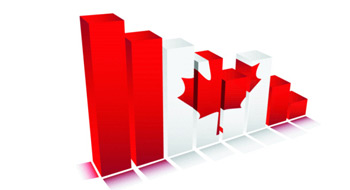

Canada’s economy recoiled for the second-straight quarter of 2015, knocking the country backwards into a technical definition of recession, Statistics Canada data reveal Tuesday.
The federal agency says real GDP contracted at an annual pace of 0.5% in the second quarter of the year, which followed a revised decline of 0.8% during the first three months of 2015.
Statistics Canada says the first-quarter performance was weaker than originally estimated, forcing the agency to lower its GDP reading for the first three months of the year from an original estimate of 0.6%.
Read: Technical recession expected to be short-lived
On the positive side, there was evidence to suggest Canada’s economy began to bounce back in June as GDP grew by 0.5% for the month after shrinking over five straight months.
That June increase was led by a 3.1% boost in natural resources extraction—the category’s first increase following seven consecutive months of decline.
The new batch of data is likely to add fuel to the heated, ongoing political debate over how best to respond to the weakened economy as parties battle for support ahead of the October 19 federal election.
It is also expected to intensify the economic argument over the severity of the technical recession—recently defined by the federal government as two consecutive quarters of negative GDP.
Prime Minister Stephen Harper has side-stepped campaign-trail questions about whether Canada was in recession this year. On Monday, he also declined to define a recession when asked about it. “I think it’s more important to describe the reality of the situation rather than to have labels,” he says.
Read: Canadian economy contracts for fifth straight month
The hobbled economy has so far shaped up to be the primary issue of the campaign, and Harper’s opponents have used his record as a bull’s-eye for their attacks.
He has reiterated a stay-the-course mantra, insisting the country must ride out external economic and market turbulence whipped up in places like China. He has argued the only domestic weakness has been in the energy sector, which has suffered from the steep slide in global oil prices.
The Tory leader has frequently cited forecasts that predict the economy will rebound in the second half of the year, including a projection by the Bank of Canada. The central bank, however, has downgraded its projections for 2015 and cut its trendsetting interest rate twice this year to cushion the blow of low crude prices.
Drilling deeper into the second-quarter data, natural resources extraction contracted by 4.5%. A considerable amount of growth in the quarter was found in household consumption at a time when interest rates remained low.
Statistics Canada found that household consumption rose by 0.6% in the second quarter, which followed a 0.1% gain in the first three months of the year. The second-quarter increase was led by 1.5% growth in transport prices.
Read: Experts split on rate cut’s impact
Exports also crept up in the second quarter by 0.1% after contracting for two consecutive quarters. Positive numbers in the June data suggest the expected turnaround could be underway.
On a monthly basis, Statistics Canada says wholesale trade rose by 1% in June after a 1.1% decrease in May and 1.6% in April. It finds that manufacturing output rose by 0.4% after contracting by 1.6% in May.
The finance and insurance sector grew by 0.7% in June and the arts and entertainment industry rose by 6.4%, thanks in large part to Canada’s role as host of the FIFA Women’s World Cup.
The last time the economy contracted over two consecutive quarters was in 2009 during the Great Recession, when GDP pulled back by 8.7% in the first quarter and 3.6% in the second.
Also read:
